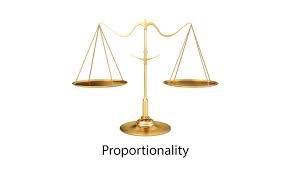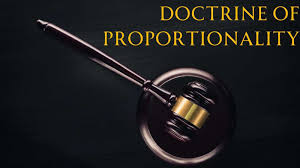


Constitutional Law | July 15, 2025
The Doctrine of Proportionality in Indian Constitutional Law and its Application in Fundamental Rights Cases
This Article is written by Anam Mishra BALLB 3rd year student from Prestige Institute of Management and Research, Department of Law Indore
Introduction
The doctrine of proportionality has emerged as a cornerstone in the field of constitutional adjudication in India. Rooted in European legal traditions and gradually integrated into Indian jurisprudence, this doctrine offers a structured framework for courts to assess whether a restriction on fundamental rights is justified. Its essence lies in maintaining a balance between individual rights and the objectives pursued by the State. As India evolves both socially and technologically, the judiciary's adoption of the proportionality principle has gained prominence in assessing State action across domains such as privacy, education, economic regulation, and national security. This paper aims to explore the evolution, structure, and application of the doctrine of proportionality in Indian constitutional law, particularly in the context of fundamental rights. It analyzes key Supreme Court judgments and reflects on how proportionality serves as a safeguard against arbitrary and excessive State power.
Legal Framework
Although the Indian Constitution does not explicitly mention the doctrine of proportionality, the principle finds implicit recognition through judicial interpretation, particularly under Articles 14, 19, and 21.
• Article 14 guarantees equality before the law and prohibits arbitrary State action. • Article 19 protects various freedoms such as speech, movement, and profession, subject to reasonable restrictions.
• Article 21 assures protection of life and personal liberty, interpreted expansively since the landmark decision in Maneka Gandhi v. Union of India (1978).
Proportionality acts as a tool for courts to ensure that any infringement upon these rights is measured, necessary, and justified. The doctrine originated in German administrative law and was adopted by European courts before being absorbed into Indian jurisprudence through judicial innovation.
Analysis
Issue
To what extent does the doctrine of proportionality guide Indian constitutional courts in assessing the validity of State action that restricts fundamental rights, and how effectively has it been implemented in key constitutional cases?
Rule
The proportionality test has evolved through jurisprudence and involves four core components, especially as clarified in K.S. Puttaswamy v. Union of India (2017): 1. Legitimate Aim: The restriction must serve a constitutionally permissible purpose. 2. Rational Connection: The measure must be logically connected to the objective. 3. Necessity: There should be no less restrictive alternative available. 4. Balancing: The benefits of the restriction must outweigh the harm caused to individual rights.
This framework is now routinely applied to assess whether the State has justifiably limited fundamental freedoms.
Application
The following landmark cases demonstrate how the doctrine of proportionality has been interpreted and applied by the Indian judiciary in diverse contexts:
1. Om Kumar v. Union of India (2001):
This was a turning point where the Supreme Court explicitly introduced the proportionality principle in administrative law. The Court distinguished between legislative and administrative action, holding that proportionality would apply primarily to the latter. While arbitrariness remained the test for legislation, the decision emphasized that administrative decisions must not be excessive and should be suitable, necessary, and balanced.
2. Modern Dental College and Research Centre v. State of Madhya Pradesh (2016): In this case, the Court upheld the state's right to regulate private professional educational institutions. It used the proportionality test to evaluate whether such regulation infringed upon the institutions’ autonomy under Article 19(1)(g). The Court ruled that the regulatory framework served the public interest of ensuring quality and transparency in education and that the interference was justified and not excessive.
3. K.S. Puttaswamy v. Union of India (2017) - Privacy Judgment:
A nine-judge constitutional bench declared the right to privacy a fundamental right under Article 21. The Court held that any restriction on privacy must meet the proportionality standard. This judgment laid the doctrinal foundation for future cases involving personal liberty, autonomy, and data protection.
4. K.S. Puttaswamy v. Union of India (2018) - Aadhaar Judgment:
In the follow-up Aadhaar verdict, the Court applied the proportionality test to determine the validity of the Aadhaar scheme. While the Court upheld the scheme for its legitimate aim of efficient service delivery, it struck down provisions allowing private access to
Aadhaar data and made the scheme voluntary for certain services, illustrating a nuanced application of the test.
5. Anuradha Bhasin v. Union of India (2020):
Challenging the internet shutdown in Jammu and Kashmir, the Court applied the proportionality test and held that such restrictions must be necessary, temporary, and must be subject to periodic review. The judgment stressed that freedom of expression and access to information are constitutionally protected, and any restriction on them must pass the proportionality scrutiny.
6. Internet and Mobile Association of India v. RBI (2020):
Here, the Supreme Court struck down an RBI circular banning financial services to cryptocurrency entities. The Court held that the restriction lacked sufficient empirical justification and was disproportionate to the goal of protecting financial stability. It reaffirmed the principle that regulatory actions impacting Article 19(1)(g) must meet proportionality standards.
These cases reflect the progressive evolution of proportionality in Indian constitutional law, establishing it as a cornerstone of rights adjudication. The test has brought in predictability and transparency in judicial review, ensuring that State action is fair, rational, and rights-respecting.
Conclusion
The doctrine of proportionality has become an indispensable tool in Indian constitutional adjudication. By requiring that restrictions on fundamental rights must pursue legitimate aims, be logically connected to their objectives, be the least restrictive means available, and balance public interest with individual harm, the doctrine ensures that State power is exercised within constitutional bounds. From administrative decisions to large-scale legislative frameworks like Aadhaar, courts have used this doctrine to uphold the spirit of constitutionalism. While concerns remain about judicial overreach, the proportionality standard provides a principled method for reconciling individual freedoms with societal needs. As emerging issues such as surveillance, digital privacy, and artificial intelligence come to the fore, the doctrine’s relevance will only grow, reinforcing its status as a pillar of constitutional governance.
References
• Om Kumar v. Union of India, (2001) 2 SCC 386.
• Modern Dental College and Research Centre v. State of M.P., (2016) 7 SCC 353. • K.S. Puttaswamy v. Union of India (Privacy Judgment), (2017) 10 SCC 1.
• K.S. Puttaswamy v. Union of India (Aadhaar Judgment), (2019) 1 SCC 1. • Anuradha Bhasin v. Union of India, (2020) 3 SCC 637.
• Internet and Mobile Association of India v. RBI, (2020) 10 SCC 274. • Upendra Baxi, 'Proportionality in Indian Constitutional Law', Indian Law Review, 2021.
• Tarunabh Khaitan, 'A Theory of Discrimination Law', Oxford University Press, 2015.



Comments (0)